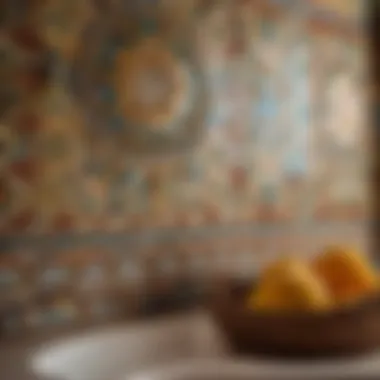Materials:
- Tile cleaner: 1 quart
- Primer: 1 gallon
- Epoxy tile paint: 2 gallons
- Paintbrushes: various sizes
- Painter's tape: 2 rolls
- Safety goggles
- Gloves
- Rags: 10
- Sandpaper: medium and fine grit
- Bucket
- Sponge
DIY Steps:
- Clean the tiles thoroughly using the tile cleaner and let them dry completely.
- Apply a layer of primer evenly on the tiles and allow it to dry for at least 24 hours.
- Stir the epoxy tile paint well and start painting the tiles using a paintbrush in smooth, even strokes.
- Apply a second coat of epoxy tile paint after the first coat has dried completely.
- Let the tiles cure for the recommended time as per the paint instructions.
Technical Aspects:
- Tools: Paintbrushes, sandpaper, bucket, sponge
- Timing: Allow 24 hours for the primer to dry before applying the epoxy paint
- Critical Techniques: Ensure even application of paint, follow manufacturer's instructions for curing
DIY Project Process:


- Start with preparing the tiles by cleaning and priming them
- Apply epoxy tile paint in smooth strokes, ensuring even coverage
- Allow sufficient drying time between coats and for curing
- Troubleshooting Tips: If paint starts to peel or bubble, sand down and repaint for a smooth finish
Introduction


In the realm of home improvement, the process of refinishing bathroom tiles holds a pivotal role in rejuvenating and enhancing the aesthetic appeal of one's living space. As homeowners seek to elevate the ambiance of their bathrooms, understanding the nuances of tile refinishing becomes imperative. This comprehensive guide aims to shed light on the intricate steps involved in this transformative process. From the initial assessment of tiles to the final coat of refinishing product, every detail plays a significant role in achieving a seamless finish that breathes new life into tired bathroom tiles.
Understanding Tile Refinishing
What is Tile Refinishing?
Tile refinishing, also known as reglazing or resurfacing, is a cost-effective alternative to replacing old or worn-out bathroom tiles. This process involves applying a new coating to the surface of existing tiles, providing a fresh appearance without the need for extensive renovations. The key characteristic of tile refinishing lies in its ability to restore tiles to their former glory, masking imperfections and revitalizing the overall look of the bathroom. This method is particularly popular for its ability to save both time and money while yielding impressive results that mimic the appearance of new tiles.
Benefits of Refinishing Bathroom Tiles
The benefits of refinishing bathroom tiles are manifold. Not only does this process offer a budget-friendly solution to updating the look of a bathroom, but it also contributes to sustainability by reducing waste from tile replacement. Moreover, refinishing allows homeowners to customize the color and finish of their tiles, opening up a realm of design possibilities. The unique feature of refinishing lies in its ability to transform a lackluster bathroom into a rejuvenated space that exudes freshness and modernity. While this method is not without its limitations, such as the requirement of a smooth tile surface for optimal results, the advantages it brings to this article's focus on revitalizing bathroom tiles cannot be understated.
Assessing Your Bathroom Tiles
Types of Tiles Suitable for Refinishing
Before embarking on the refinishing process, it is crucial to determine the type of tiles in your bathroom that are suitable for refinishing. Ceramic tiles are generally good candidates for refinishing, given their durability and ability to hold a new coat of refinishing product. Porcelain tiles also respond well to this method, offering a smooth and non-porous surface that enhances the adhesion of the refinishing material. On the other hand, natural stone tiles like marble or travertine may require specialized refinishing techniques due to their unique characteristics and porosity. Understanding the types of tiles suitable for refinishing sets the foundation for a successful tile renewal project.
Identifying Damage and Wear
In the process of assessing bathroom tiles, it is essential to identify any damage or wear that may affect the refinishing outcome. Cracks, chips, or discoloration are common issues that signify the need for tile refinishing. By pinpointing these areas of concern, homeowners can prioritize repairs and preparations to ensure a seamless refinished surface. Examining the extent of damage and wear also guides the selection of suitable refinishing products and techniques that address specific tile imperfections. This meticulous assessment stage forms the basis for a tailored refinishing approach that tackles individual tile conditions effectively.
Gathering Supplies
Essential Tools and Materials
Equipping oneself with the essential tools and materials for tile refinishing is paramount to a successful renovation project. Among the must-have items are a tile cleaner, abrasive pads, putty knife, epoxy filler, refinishing primer, acrylic urethane topcoat, and quality paintbrushes or sprayers. Each tool and material serves a distinct purpose in the refinishing process, from prepping the tile surface to applying the final protective layer. The key characteristic of these supplies lies in their ability to enhance the durability and aesthetics of the refinished tiles, ensuring a professional-looking result that stands the test of time.
Safety Precautions
While engaging in tile refinishing, prioritizing safety precautions is non-negotiable. Ventilation is crucial to dissipate fumes from refinishing products, protecting the respiratory health of individuals working in the bathroom. Wearing appropriate personal protective equipment, such as gloves, goggles, and a respirator, safeguards against skin irritation and inhalation of harmful chemicals. Additionally, having a well-ventilated space and avoiding direct skin contact with refinishing materials minimizes potential health risks during the refinishing process. Integrating safety measures into every stage of tile refinishing ensures a secure and healthy environment for both homeowners and applicators, underscoring the importance of responsible home improvement practices in this article's context.
Preparation


In the realm of refinishing bathroom tiles, the preparation phase serves as the cornerstone of a successful restoration project. Thorough preparation ensures that the subsequent steps, from cleaning to refinishing, are executed effectively. Not only does proper preparation enhance the longevity of the refinished tiles, but it also significantly impacts the final aesthetic outcome of the project. Housewives and homeowners embarking on tile refinishing should dedicate ample time to this crucial stage, as it sets the foundation for a durable and visually appealing revamp.
Cleaning the Tiles
Removing Grime and Residue
The meticulous process of removing grime and residue from bathroom tiles is a fundamental aspect of preparing surfaces for refinishing. This step involves eliminating accumulated dirt, soap scum, and other impurities that have adhered to the tile surface over time. By thoroughly cleansing the tiles, individuals create a smooth and clean canvas that facilitates optimal adhesion of subsequent refinishing products. Adopting this method ensures that the refinishing solution bonds effectively to the tiles, resulting in a flawless and long-lasting finish.
Mold and Mildew Removal
Addressing mold and mildew growth is pivotal during the tile refinishing preparation phase. Mold and mildew not only detract from the visual appeal of the bathroom but also pose health risks to occupants. Removing these unsightly and hazardous infestations involves using suitable cleaning agents to eradicate spores and prevent regrowth. By prioritizing mold and mildew removal, individuals can safeguard their families' health while enhancing the overall cleanliness and appearance of the bathroom.
Repairing Damaged Tiles
Filling Chips and Cracks
Effective restoration of damaged tiles entails meticulously filling chips and cracks to ensure a smooth and uniform surface. This process requires precision and attention to detail to seamlessly mend imperfections and prevent further deterioration. Filling chips and cracks not only improves the visual aspect of the tiles but also reinforces their structural integrity, enhancing durability and longevity.
Replacing Broken Tiles
When tiles exhibit irreparable damage, such as extensive breakage or deep cracks, replacing them is the most suitable course of action. By carefully removing damaged tiles and installing new ones, individuals can maintain a cohesive and aesthetically pleasing tile surface. This method not only resolves safety concerns associated with sharp or loose tiles but also contributes to the overall harmony and visual appeal of the refurbished bathroom.
Surface Preparation
Smoothing Rough Areas
Smoothing rough areas on tiles plays a crucial role in preparing surfaces for refinishing. Uneven or rough patches can inhibit the proper adhesion of refinishing products, leading to a subpar finish. By meticulously smoothing rough areas, individuals ensure a seamless and uniform surface that promotes optimal product application and adherence. This meticulous approach guarantees a polished and professional result that enhances the overall aesthetic of the bathroom.
Applying Primer
Prior to applying the final coat of refinishing product, applying primer is essential to enhance adhesion and longevity. Primer acts as a foundation that maximizes the durability and lifespan of the refinishing solution while creating a strong bond with the tile surface. By incorporating primer into the preparation process, individuals fortify the foundation of their refinishing project, ensuring a robust and enduring finish that withstands daily use and exposure to moisture.
Refinishing Process
Refinishing the bathroom tiles is a crucial step in the overall process of revitalizing your bathroom space. This section focuses on the detailed refinishing process, which plays a crucial role in bringing a refreshed look to your tiles. By following the refinishing process carefully, you can achieve a professional finish that enhances the aesthetic appeal of your bathroom.
Choosing the Right Refinishing Product
In the realm of tile refinishing, selecting the right product is paramount to the success of your project. The types of tile refinishing products available in the market cater to different needs and preferences, ensuring a customized approach to your tile renovation. Understanding the characteristics and benefits of these products will help you make an informed decision based on your specific requirements.
Types of Tile Refinishing Products
When it comes to types of tile refinishing products, each variant offers distinct advantages tailored to various tile surfaces. From epoxy coatings to acrylic refinishing kits, the market provides a range of options to suit different tile materials and desired outcomes. Exploring the unique features and applications of these products will guide you in choosing the most suitable option for your bathroom tiles, ensuring a durable and visually appealing finish.
Matching Colors and Finishes
Matching colors and finishes is a crucial aspect of tile refinishing, as it determines the final look of your tiles. This process involves selecting a color that complements your existing bathroom decor while ensuring a seamless finish that enhances the overall aesthetic appeal. Understanding the characteristics of different colors and finishes will enable you to achieve a cohesive design that transforms your bathroom tiles into an elegant focal point.
Application Techniques
The application techniques employed during the tile refinishing process significantly impact the final result. Whether you opt for rolling or spraying, each method offers unique advantages and considerations that influence the quality of the finish. By mastering the application techniques and understanding how to avoid drips and streaks, you can ensure a professional-looking outcome that revitalizes your bathroom tiles with precision and finesse.
Rolling vs. Spraying
The choice between rolling and spraying as application techniques depends on several factors, including the type of product used and the desired finish. While rolling offers control and precision, spraying ensures even coverage and a smooth surface. By weighing the benefits and drawbacks of each technique, you can select the most suitable method that aligns with your refinishing goals and expertise level.
Avoiding Drips and Streaks
One of the key challenges during tile refinishing is avoiding drips and streaks, which can compromise the overall finish. Implementing proper technique and maintaining a consistent application speed are essential in preventing flaws and achieving a flawless result. By adopting best practices and paying attention to detail, you can mitigate the risk of drips and streaks, ensuring a professional-grade outcome that enhances the beauty of your bathroom tiles.
Drying and Curing
After applying the refinishing product, allowing adequate drying and curing time is crucial for achieving optimal results. Proper ventilation plays a vital role in facilitating the drying process, ensuring uniform drying and minimizing the risk of imperfections. Understanding the importance of curing time is also essential, as it determines the durability and longevity of the refinished surface, ultimately influencing the overall success of your tile renovation project.
Proper Ventilation
Proper ventilation is a critical aspect of the drying and curing process, as it promotes airflow and accelerates drying time. Adequate ventilation expedites the evaporation of solvents and enhances the product's adhesion to the tile surface, resulting in a more resilient finish. By ensuring proper ventilation during the refinishing process, you can optimize the drying conditions and achieve a professional outcome that withstands everyday wear and tear.
Curing Time
The curing time of the refinishing product dictates when the tiles can be exposed to moisture and regular usage. Allowing sufficient curing time is essential for maximizing the product's durability and resistance to water and cleaning agents. By adhering to the recommended curing time, you can safeguard the newly refinished tiles and maintain their pristine appearance over the long term. Patience during this phase is key to enjoying the full benefits of the refinishing process and ensuring a flawless finish that stands the test of time.
Finishing Touches
In the final phase of refinishing your bathroom tiles, the finishing touches play a crucial role in sealing and protecting your hard work. These last steps not only enhance the aesthetic appeal of your tiles but also ensure their longevity and durability. By focusing on sealing and protecting your refinished tiles, you can maintain their pristine condition for an extended period.
Sealing and Protecting
Benefits of Sealing
Sealing your refinished bathroom tiles offers a myriad of benefits that contribute to the overall success of this renovation project. One key characteristic of sealing is its ability to create a protective barrier that prevents moisture, dirt, and stains from penetrating the tiles. This waterproof seal not only enhances the tiles' durability but also simplifies cleaning and maintenance routines. The unique feature of sealing lies in its capacity to extend the lifespan of your tiles by shielding them from everyday wear and tear. By incorporating sealing into this article, readers can understand the importance of this step in preserving the beauty and functionality of their refinished bathroom tiles effectively.
Maintenance Tips
Providing maintenance tips as part of the finishing touches section is essential for guiding readers on how to care for their newly refinished tiles. Key characteristics of these maintenance tips include using mild, non-abrasive cleaners to prevent damage to the sealed surface and avoiding harsh chemicals that may degrade the sealant over time. By emphasizing regular cleaning schedules and proper maintenance techniques, readers can enjoy long-lasting results from their tile refinishing project. The unique feature of maintenance tips is their role in ensuring that the sealed tiles retain their aesthetic appeal and structural integrity over time. By incorporating these tips into the article, readers can gain valuable insights into preserving the pristine condition of their refinished bathroom tiles.
Cleaning Up
After sealing and protecting your refinished tiles, the cleaning up process is essential for completing the project and returning your bathroom to its original state. This phase involves removing any tape and coverings used during the refinishing process and properly disposing of materials to ensure a clean and safe environment.
Removing Tape and Coverings
An integral aspect of the cleaning up phase is the careful removal of tape and coverings that were utilized to protect areas adjacent to the tiles during refinishing. The key characteristic of this step is to ensure that no adhesive residue or damage is left behind on surfaces surrounding the tiles. By detailing appropriate techniques for removing tape and coverings without causing harm to the underlying surfaces, this article assists readers in achieving a professional and polished finish for their tile refinishing project.
Proper Disposal of Materials
Properly disposing of materials used during the tile refinishing process is vital for environmental sustainability and household safety. The key characteristic of this task is to separate and dispose of materials according to local regulations to minimize ecological impact. By highlighting the importance of responsible waste disposal and sharing tips on how to safely discard leftover products, readers can engage in eco-friendly practices while completing their bathroom renovation. This unique feature promotes awareness of environmental considerations in home improvement projects and encourages readers to adopt responsible waste management practices.
Admiring Your Refinished Tiles
With the completion of the tile refinishing process, taking time to appreciate the transformation and showcase your work adds a sense of accomplishment to the project. This section allows readers to admire the renewed beauty of their bathroom tiles and celebrate their successful efforts in revitalizing the space.
Appreciating the Transformation
Appreciating the transformation of your bathroom tiles involves recognizing the impact of the refinishing project on the overall look and feel of the space. The key characteristic of this aspect is acknowledging the enhanced visual appeal and renewed freshness that refinished tiles bring to the bathroom. By highlighting the transformative power of tile refinishing, readers can gain a deeper appreciation for the difference this process makes in upgrading the aesthetic of their home environment. The unique feature of appreciating the transformation lies in embracing the positive changes that refinished tiles bring to the bathroom, fostering a sense of pride and satisfaction in the completed renovation.
Showcasing Your Work
Showcasing your refinished tiles allows you to share your hard work and creativity with others while also inspiring them to embark on their own home improvement projects. The key characteristic of showcasing your work is the ability to display the before-and-after transformation of your bathroom tiles, illustrating the significant impact of the refinishing process. By providing tips on how to photograph and present the refinished tiles effectively, this article supports readers in sharing their accomplishments with friends, family, and online communities. The unique feature of showcasing your work is its role in inspiring others to consider tile refinishing as a feasible and rewarding home renovation option, paving the way for greater creativity and personalization in interior design projects.





